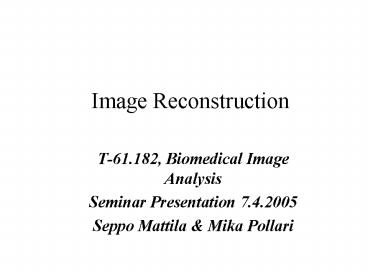Image Reconstruction - PowerPoint PPT Presentation
Title:
Image Reconstruction
Description:
... of Tissue Composition MRI Reconstruction MRI Signal Reconstruction Examples Effects of Sampling the K-space Functional MRI (data from AMI GE 3T) ... – PowerPoint PPT presentation
Number of Views:194
Avg rating:3.0/5.0
Title: Image Reconstruction
1
Image Reconstruction
- T-61.182, Biomedical Image Analysis
- Seminar Presentation 7.4.2005
- Seppo Mattila Mika Pollari
2
Overview
- Reconstruction from projections (general)
- projection geometry and radon transform
- Reconstruction methods
- Backprojection, (Fourier slice theorem), Filtered
Backprojection, and Algebraic Reconstruction
Technique - Reconstruction examples
- MRI reconstruction
- examples
3
Introduction
- Only photography (reflection) and planar x-ray
(attenuation) measure spatial properties of the
imaged object directly. - Otherwise, measured parameters are some how
related to spatial properties of imaged object. - US (amplitude and time), CT, SPECT and PET
(integral projections of parallel rays), MRI
(amplitude, frequency and phase of the NMR
signal) etc... - Construct the object (image) which creates the
measured parameters.
4
(No Transcript)
5
Reconstruction From the Projections
- Projection is a line integral along the path
- CT measure the projections of passed photons,
with different angles. - MRI measure projection of NMR signal with
different magnetic gradients (projection based
MRI not used anymore). - Assumption no notable diffraction.
6
Projection Geometry and Radon Transformation
- Co-ordinate transformation
- Radon transformation
7
(No Transcript)
8
Backprojection (BP)
- Simplest reconstruction method Integrate all
possible rays that pass through the same point. - Cause smearing and blurring. Method has nowadays
only historical importance.
9
Backprojection Graphically
10
(No Transcript)
11
(No Transcript)
12
(No Transcript)
13
(No Transcript)
14
FBP ramp vs. smooth filter
15
FST and FBP
- Starting from FST we end up to FBP without any
approximations or assumptions
16
Remarks of FBP
- From the previous equations its clear that the
image is backprojection of filtered signal (
) and (w) is the ramp filter. - FBP advantages
- Each projection may be filtered and backprojected
while further projections are collected (on-line
processing). - No need for 2D inverse Fourier transformation.
17
Algebraic Reconstruction Techniques (ART)
- Each object entity (image pixel/voxel) has
physical property (grey-level value) such as
attenuation coefficient - All pixel in the rays path contribute to sum an
amount which equals pixels area along the path
(weight) times pixels physical property
(grey-level value) - We end up set of simultaneous equations
18
ART Model
- Each ray sum
- Set of simultaneous equations
19
Kaczmarz Method Solution to ART
- Each equation spans a hyperplane in n-dimensional
space. If unique solution exist it is in
intersection of the hyperplanes - Solution is found iteratively by solving each ray
equation at the time
20
(No Transcript)
21
Reconstruction Examples Number of Projection
22
Reconstruction Examples Projection Angle
BP
FBP (Butter)
ART
PSF
23
Reconstruction Examples BP, FBP, and ART
Phantom
BP
FBP (Butter)
ART
Reconstruction of phantom with different
reconstruction methods using 90 projections from
interval 0-180 degree
24
Display of CT Images Using Hounsfield Units
- Attenuation coefficients are normalized with
respect of water - Now mean and SD of of different tissues are known
advanced (measured in HU)
25
(No Transcript)
26
MRI Reconstruction
27
MRI Signal
28
(No Transcript)
29
(No Transcript)
30
Reconstruction Examples
31
Effects of Sampling the K-space
32
(No Transcript)
33
(No Transcript)
34
(No Transcript)
35
Summary I
- Reconstruct 2D CT image from 1D projections
- Backprojection (BP)
- - Only historical importance
- Filtered backprojection (FBP)
- - Most widely used technique
- - Large number of projections over 0-180
required - Algebraic Reconstruction Techniques (ART)
- - Better handling of sparse and non-uniform
projections - - Slow compared to FBP
36
Summary II
- Reconstruct 2D MR image from measured current
(1D) - Spatial (x,y) info encoded in frequency and
phase - Collect data to spatial frequency domain
(k-space) - Reconstruction by inverse 2D FT
- non-invasive
- imaging sequences (T1, T2, fMRi etc.) lots
of possibilities - - image artifacts (distortions, ghosts, etc.)
- - more expensive































